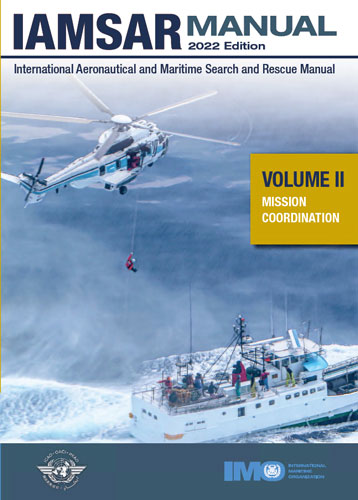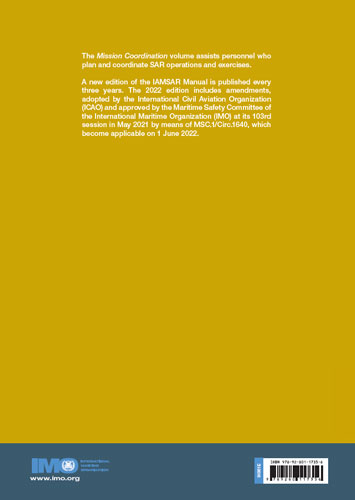Международное авиационное и морское наставление по поиску и спасанию (Наставление ИАМСАР), книга II – "Координация миссии". IAMSAR Manual, Volume II – "Mission Coordination"
Книга на английском языке
The primary purpose of the three volumes of the International Aeronautical and Maritime Search and Rescue Manual (IAMSAR Manual) is to assist States in meeting their own search and rescue (SAR) needs, and the obligations they accepted under the Convention on International Civil Aviation, the International Convention on Maritime Search and Rescue, 1979 and the International Convention for the Safety of Life at Sea, 1974 (SOLAS). These volumes provide guidelines for a common aviation and maritime approach to organizing and providing SAR services. States are encouraged to develop and improve their SAR services, cooperate with neighbouring States and to consider their SAR services to be part of a global SAR system.
Volume II Mission coordination
Contents
Foreword
Abbreviations and acronyms
Glossary
Chapter 1 The search and rescue system
1.1 System organization
1.2 SAR coordination
1.3 SAR resources
1.4 Medical assistance to vessels
1.5 Plans of operation
1.6 SAR operations stages
1.7 Mission documentation
1.8 Training and exercises
1.9 Improving professionalism
1.10 Public relations
1.11 Computer resources
1.12 Decision and management support
Chapter 2 Communications
2.1 Distress communications
2.2 Aeronautical mobile service
2.3 Maritime radio service
2.4 Modes of emission
2.5 Global Maritime Distress and Safety System
2.6 406 MHz distress beacons – EPIRB, ELT and PLB
2.7 Satellite communications
2.8 Vessel–aircraft communications
2.9 Survival and emergency radio equipment
2.10 Mobile telephones – satellite and cellular
2.11 Special circumstances
2.12 Communications for SAR operations
2.13 Communication equipment identities
2.14 False alerts
2.15 SAR data providers
2.16 RCC and RSC communications
2.17 Maritime radio telex
2.18 Maritime safety information services
2.19 Broadcast services
2.20 Radio telegraph
2.21 Phonetic alphabet and figure code
2.22 Spoken emergency signals and procedural words
2.23 On-scene communications
2.24 Electronic positioning
2.25 Codes, signals and standard phrases
2.26 First RCC
2.27 SAR operations communications
2.28 SAR operations messages
2.29 GMDSS Master Plan
2.30 Supplemental capabilities
2.31 Difficulties in contacting vessels
2.32 Unbarring of Inmarsat SESs by RCCs
2.33 Radio call signs for aircraft involved in a search and rescue operation
2.34 Vessel tracking communications
2.35 Additional device considerations
2.36 Social media
Chapter 3 Awareness and initial action
3.1 General
3.2 SAR stages
3.3 Emergency phases
3.4 Awareness stage
3.5 Initial action stage
3.6 Designation of the RCC or RSC responsible for initiating SAR action
3.7 RCC procedures for requesting SAR facilities
3.8 General considerations for the SMC
Chapter 4 Search planning and evaluation concepts
4.1 Overview
4.2 Evaluating the situation
4.3 Estimating the distress incident location
4.4 Survivor motion after the distress incident
4.5 Total probable error of position
4.6 Search planning and evaluation factors
4.7 Optimal search effort allocation
4.8 Computer-based search planning aids
Chapter 5 Search techniques and operations
5.1 Overview
5.2 Selection of search facilities
5.3 Assessing search conditions
5.4 Selecting search patterns
5.5 Visual search patterns
5.6 Electronic search patterns
5.7 Night search patterns
5.8 Land search patterns
5.9 Search object motion
5.10 Assignment of search sub-areas to individual facilities
5.11 Designation and description of search sub-areas
5.12 Planning on-scene coordination
5.13 Search action plans
5.14 Conduct of the search
5.15 Briefings
5.16 Aircraft search procedures
5.17 Surface facility search procedures
5.18 Search by land facilities
5.19 Debriefing of search personnel
5.20 Continuation of search
5.21 Geographic referencing
Chapter 6 Rescue planning and operations
6.1 General
6.2 Sighting and subsequent procedures
6.3 Delivery of rescue personnel and equipment
6.4 Supplies and survival equipment
6.5 Supply dropping
6.6 Medical personnel
6.7 Rescue by aircraft
6.8 Rescue by maritime facilities
6.9 Rescue by land facilities
6.10 Use of pararescue teams
6.11 Special requirements at aircraft crash sites
6.12 Ditching assistance
6.13 Rescue of persons from inside damaged, capsized, or ditched craft
6.14 Underwater search and rescue
6.15 Mass rescue operations
6.16 Search and rescue within areas remote from SAR facilities
6.17 Care of survivors
6.18 Debriefing of survivors
6.19 Handling of deceased persons
6.20 Critical incident stress
6.21 Termination of rescue
Chapter 7 Multiple aircraft SAR operations – General guidance
7.1 Overview
7.2 Area of SAR action
7.3 Aircraft coordinator (ACO)
7.4 Communications
7.5 Search mission
7.6 Evacuation missions
7.7 Long-range operations
7.8 Effects of the environment and weather
Chapter 8 Emergency assistance other than search and rescue
8.1 General
8.2 Intercept and escort services
8.3 Safety information
8.4 Unlawful acts
8.5 Search and rescue outside of RCC responsible areas
8.6 Assistance to property
8.7 Aerodrome emergency plan
Chapter 9 Conclusion of SAR operations
9.1 General
9.2 Closing a SAR case
9.3 Suspending search operations
9.4 Reopening a suspended case
9.5 Final reports
9.6 Performance improvement
9.7 Case studies
9.8 Archiving case files
9.9 Incident debriefings
Appendices
Appendix A Distress communications
Appendix B Message formats
Appendix C Mass rescue operations: exercises, industry roles and incident management
Appendix D Uncertainty phase data
Appendix E Alert phase data
Appendix F Distress phase checklist
Appendix G Facilities and equipment selection
Appendix H Operation briefing and tasking forms
Appendix I SITREPs and MAREC Code
Appendix J Intercepts
Appendix K Determining datum
Appendix L Search planning and evaluation worksheets
Appendix M Preparing initial probability maps
Appendix N Tables and graphs
Appendix O Ship reporting systems for SAR
Appendix P Functional characteristics to consider with computer-based search planning aids
Appendix Q Sample problem
Appendix R Medical assistance at sea, TMAS – TMAS Medical information exchange form
Appendix S Search planning for 121.5 MHz distress beacon alerts
Appendix T Checklists and guides for multiple aircraft SAR operations
Appendix U Mobile telecommunications device location process
Appendix V Autonomous distress tracking of aircraft in flight




